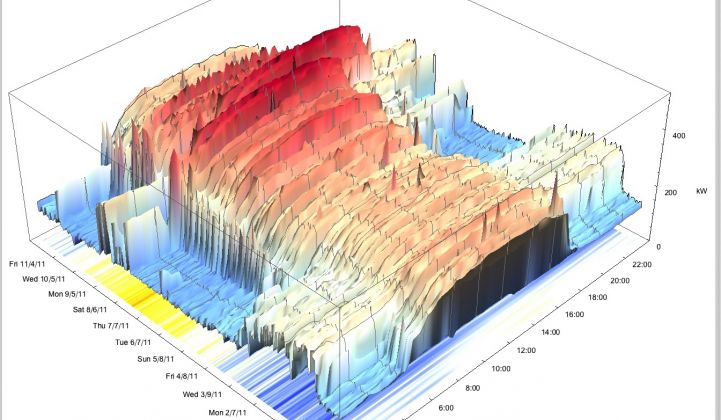Squeezing insight out of building energy data isn’t as easy as it sounds. Sure, building energy dashboards can show how much energy the building is using and how much it’s costing at any point in time. Likewise, past data can be put into graphs and charts to catch trends that indicate a failure to run an existing building’s systems most efficiently, or opportunities to invest in new efficiency measures.
But once you start adding in weather data, occupancy and use data, and other factors that influence energy use, those graphs and charts start to get complicated and hard to read. What’s the best way to compile all that information into a graphical interface that actual human beings can use to catch the efficiencies that are being missed amidst all the noise?
Agilis believes it has an answer. The self-funded, mother-son energy consulting firm from McLean, Va. has developed a software platform that crunches tens of thousands of variables like the ones listed above, based on the reams of data the company collects from public sources and its own business, and presents it in a three-dimensional graphic that helps clients recognize hidden opportunities in greening their building portfolio.
Since launching its platform in 2009, Agilis has lined up a pretty impressive list of customers for its software-as-a-service technology, including Constellation Energy, which has used it to help its commercial real estate customers reduce waste and make efficiency investments that have been paying themselves off in six months to a year or so -- an enviably fast ROI for the building energy efficiency world.
Other customers include real estate companies like Boston Properties, Federal Capital Partners and KBS Realty Advisors, which have piloted the Agilis systems in Washington, D.C.-area buildings and found ways to shave power costs by an average of 10 percent to 15 percent with little or no upfront investment.
That’s a pretty standard range for the savings that the Agilis platform can deliver, founder and CEO Joe Hirl said in an interview -- but sometimes the savings can add up to as much as 50 percent.
It all depends on how well the building is running today, compared to how well it could be running. See some red “peaks” in your building’s energy use on certain days over the course of a month? That’s excess energy use, possibly to respond to hotter-than-usual days -- or possibly because you’re not cooling the building early enough to avoid kicking AC units into overdrive during hot afternoons.
What about those blue-colored peaks showing up during the nighttime or on weekends? That’s a sure sign that someone has mis-programmed the building’s system for shutting down during non-work hours -- “That’s some of the easiest stuff to fix,” Hirl noted.
Agilis isn’t alone in bringing technology to bear to improve building efficiency visibility and energy performance, of course. Smart building analytics is an increasing focus of energy services giants like Constellation (now owned by Exelon), Honeywell, Johnson Controls, Siemens, Schneider Electric and a host of others, as well as startups and new entrants such as EnerNOC, SCIenergy, Viridity Energy, BuildingIQ, FirstFuel, Retroficiency and SkyFoundry, to name a few.
But the Agilis platform also goes deeper into some of the tricky issues that arise for buildings and their energy bills. Hirl, a former U.S. Navy nuclear power officer, has experience in that building-energy nexus -- prior to founding Agilis in 2003, he spent more than a decade managing energy trading businesses for both Progress Energy in the United States and Enron in Scandinavia, Australia and Japan.
Take demand charges -- penalties that commercial customers have to pay when they exceed a set limit for power use at any single time, imposed by utilities to keep total power draw on the grid in control. Agilis can graph a building’s power usage against other buildings of its class and tell the building owner if their building is using too much power overall. But it can also tell the owner if they’re power use is fluctuating too much, and thus leading to its demand charges being imposed too often.
Likewise, buildings can sometimes be too aggressive about turning down their building power use during non-work hours, he said. That can become a problem if the building’s HVAC system has to ramp up too hard in the morning to bring the building back up to the proper temperature, since that can actually use more energy than was saved by turning off the gear in the first place. The Agilis system can catch such overly aggressive power management strategies, and help the building owner revise its policies to reach a more even-keeled approach to shaving off-work power bills.
For less sophisticated customers, Agilis provides its software as a service, helping them understand what it’s telling them and how to adopt new procedures to take advantage of the information. It also works with customers to gather the critical fifteen-minute interval power meter data that shows the building’s energy use profile, whether via submeters in the buildings or through utility data.
For more sophisticated customers like Constellation, Agilis can provide the platform as a “modified SaaS” product that they can run on their own, Hirl said. In this case, Agilis still collects the data from those projects -- an important fact, given that data is the lifeblood for the company’s analytics engine -- but the customer does most of the analysis and makes their own decisions, he said.
Agilis is working with a number of partners in this category, Hirl said. One partner is Trane, the big HVAC company owned by Ingersoll Rand, which is using Agilis for building energy diagnostics, he said, though he wouldn’t provide more details. Agilis is also deploying in Southern California Edison territory in partnership with a big energy services company, he said, but he wouldn’t name the partner.



